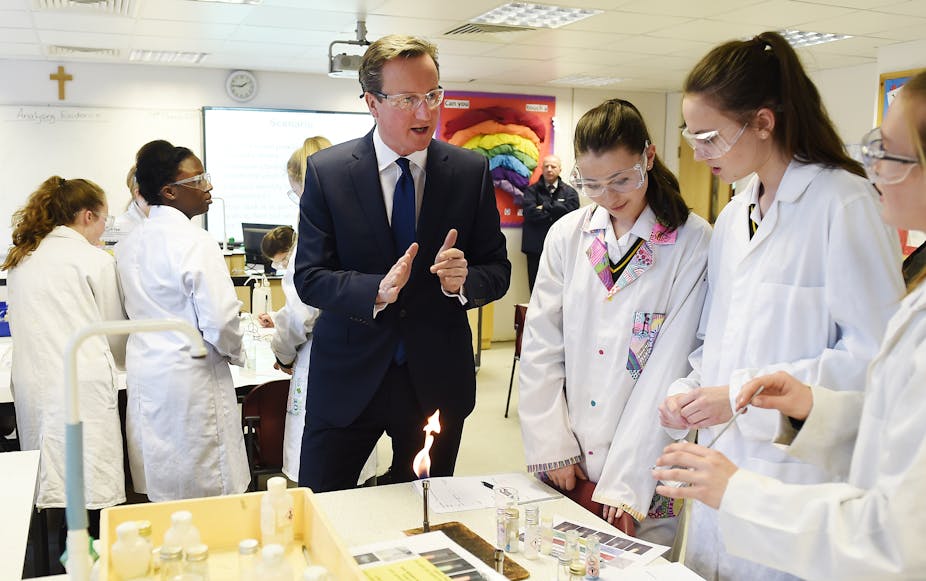No-one foresaw the scale of the Conservative victory – it exceeded even the limits of the party’s own expectations. Now, a majority Conservative government comes to power – unexpectedly and with sufficient lead over a divided and, for Labour and the Liberal Democrats, demoralised opposition. What will this newly confident government mean for education in general and schools in particular?
The Conservative education manifesto was long on aspiration. It promised that England would lead the world in mathematics and science; that there would be a place in a “good” primary school for every child; that every “failing” or coasting school would be turned into an academy to drive up standards; that universities would remain “world-leading”; and that further education would “improve”. But translating these – rightly aspirational – goals into policies will bring some difficult challenges.
David Cameron ruled out a real-terms increase in school spending, but promised to protect per-pupil spending. This means that school funding will increase in line with pupil numbers, but not with inflation or cost pressures, including National Insurance changes.
Funding squeeze ahead
The Institute for Fiscal Studies calculated that this meant schools could face cuts of up to 12% over the course of the parliament. Unlike their erstwhile coalition partners, the Liberal Democrats, the Conservatives declined to include further education in their ring fence, which raises the spectre that the further education budget could be under greater pressure. Already, planned post-16 funding changes are placing a huge squeeze on the breadth of curriculum in school sixth forms.
For universities, wage inflation, increased pension and National Insurance costs and cuts to capital budgets mean that the ceiling of £9,000 a year on undergraduate fees is a diminishing resource: while the Conservatives have not ruled out increasing the £9,000 fee cap, such a move would be politically challenging.
If funding is going to be tight, so too will accountability for both schools and pupils. The Conservatives promised to introduce a new test for pupils who do not reach expected levels in English and Mathematics at the end of Key Stage 2 (age 11). The promise drew widespread criticism from school leaders and teachers and the international evidence on repeating tests in successive years as a lever for improved attainment is generally negative.
They look to a tightening of demands on schools. It appears that they will require all pupils to take GCSEs in the English Baccalaureate subjects (English, mathematics, science, a language and history or geography), and they have promised to turn all schools they describe as “coasting” or “failing” into academies – essentially those with OFSTED grades 3 or 4. But while some academy groups have been extremely effective in improving the performance of struggling schools, not all have, and the struggle to find enough high-quality school sponsors looks to become increasingly difficult.
There is also, it appears, a commitment to a new accountability framework to recognise teaching quality in universities drawing on the claimed parallel of the Research Excellence framework for research quality. This was something that was prefigured but never really developed in Labour’s 2003 universities White Paper.
Full speed ahead on free schools
There will be further diversification of education provision and types. The Conservative promise 500 new “free” schools, as well as new University Technical Colleges, a new further education network of National Colleges and a strong commitment to extending online education in universities. Schools of all types – including grammar schools – will be allowed to expand.
But there is little reference in the manifesto to ensuring that new and diversified school and further education provision will be in the places of highest need. Some University Technical Colleges have already closed, and while some “free” schools have been a success, others have been well-publicised failures. Delivering diversity is a strong theme of the manifesto – but so is the commitment to ensure that there is a good primary school place for every child. The balance between the development of an education market in new provision (although “for profit” schools have previously been ruled out) and effectively planned provision will be difficult.
This is especially the case in the face of the biggest challenge facing the new government: the need to provide an additional 500,000 school places to meet demographic growth over the next five years. This effectively means something like an additional 25,000 teachers on top of the number needed to maintain teacher supply. The manifesto commits to (effectively) doubling the number of new maths and science teachers being trained each year – something which is easier said than done.
The Conservative poll success has been striking. At root, it means that the radical Michael Gove reforms – to governance, curriculum and assessment – will be embedded, and that the English school system will continue to be radically reformed. We will have a largely autonomous system of competing schools and school groups in a high accountability framework. It will look like few other publicly funded school systems in the world, and the challenge of delivering the high aspirations which – rightly – the Conservatives have offered for every child in such a framework should not be underestimated.
*** This article was also published on the IOE London Blog***

